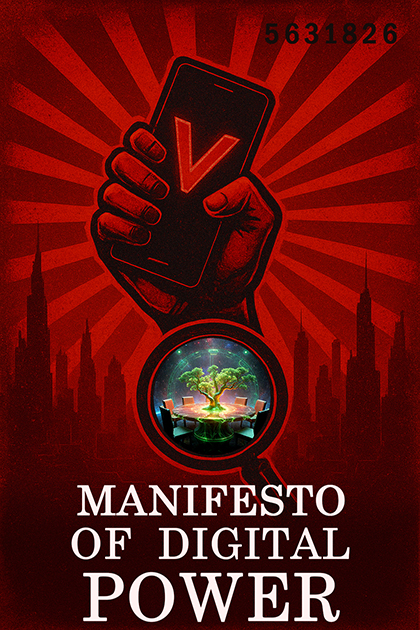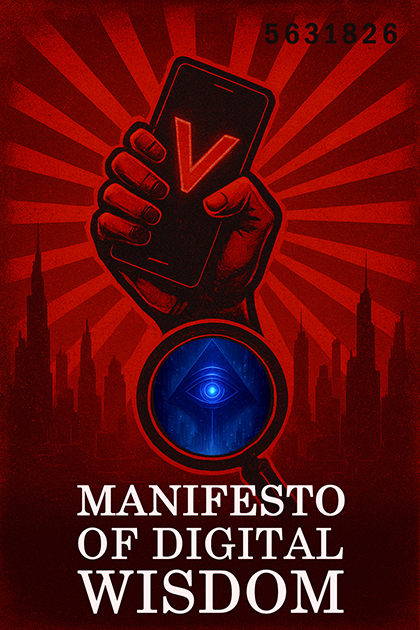Whitepaper
The Virtublic Party
Abstract
The Virtublic Party is a socio-political experiment aimed at constructing a sustainable model of a digital Republic. Through the synthesis of the ideology of personal sovereignty, an evolutionary organizational structure, and a minimalist resource model, the project establishes an alternative to conventional digital ecosystems — one in which human consciousness retains primacy over algorithmic influence.
1. Introduction: The Crisis of Digital Sovereignty
The modern digital environment reveals a fundamental contradiction: technological progress, which once promised the expansion of freedom, has in practice created a new form of dependence. Platform algorithms appropriate user data and attention, transforming the individual into an object of manipulation — deprived of control over their digital identity and agency.
Solution: Virtublic is a digital Republic where personal sovereignty is inalienable, and power is built from the bottom up through continuous processes of democratization.
2. Ideological Foundations
2.1. Project Axioms
- Primacy of Consciousness: Human consciousness is the source of meaning and the final instance of legitimacy.
- Personal Sovereignty: Every digital sovereign controls their own being.
- Voluntary Association: Power arises from conscious consent and shared responsibility.
2.2. Critique of Modernity
The project stands in opposition to the Digital Totalitarianism of corporate platforms.
3. Organizational Architecture
3.1. Transitional Coordination
The initial structure is centralized to ensure security and coordination. The process unfolds in three phases:
- Transitional coordination
- Stepwise federalization
- Full decentralization
3.2. Cell Structure
- Cells (5–15 participants): The basic organizational unit.
- Parallel networks of cells formed by functional or thematic principle.
- Executive cells: Autonomous groups for specific missions.
- Coordinating cells: Responsible for strategic alignment of directions.
3.3. Roles and Checks
- Sovereign: Basic identity, minimal rights.
- Virtublican: Participant who has accepted the Declaration.
- Evolutionary Activist: Member involved in operational activity.
- Coordinator: Ensures procedural control and compliance with regulations.
- Leader: Operational governance under a system of checks and balances.
4. Resources and Support
4.1. Principle of Minimal Sufficiency
The project deliberately limits resources to prevent the commercialization of ideological goals.
4.2. Support Model
- Voluntary contributions from participants.
- Resource allocation follows principles of transparency and collective responsibility.
- Funds are directed toward maintaining infrastructure, content, and organizational processes.
4.3. Distinction from Commercial Models
The project is not MLM, not crowdfunding, and not a subscription model — it is solely dedicated to supporting the ideology and development of Virtublic.
5. Reputation System (VIC)
5.1. Three-Axis Model
- Contribution: Completed tasks and engagement of supporters.
- Time: Consistency and sustainability of participation.
- Verification: External confirmations and achievements.
5.2. Functions of VIC
- Mechanism of access to governance roles.
- Basis for resource distribution.
- Instrument for building trust within the system.
6. Protection Against Hostile Takeover
6.1. Technical Measures
- OpSec standards for leadership positions.
- Two-factor authentication and encrypted communications.
- Anomaly monitoring system.
6.2. Governance Mechanisms
- Restriction of external influences.
- Emergency response protocols.
- Right of Coordinators to suspend controversial decisions.
6.3. Transparency and Accountability
- Regular audits.
- Public reporting.
- Clear dispute resolution procedures.
7. Roadmap of Transition
- Phase I — Formation (0–12 months): Building the core team, establishing base infrastructure, launching VIC, and reaching critical mass (10,000 digital sovereigns).
- Phase II — Expansion (12–24 months): Scaling the cell structure, testing internal resource models, developing the constitutional foundations of Virtublic.
- Phase III — Federalization (24+ months): Transition to a decentralized governance system, full implementation of digital democracy, and internal legitimation through participant processes.
8. Philosophical Foundation
8.1. Reinterpreting the Social Contract
- Conscious consent replaces territorial belonging.
- Delegation of power proceeds from the bottom up.
- Individual sovereignty is preserved over collective structures.
8.2. Ethics of Digital Existence
- Expansion of agency, not its limitation.
- Development of consciousness, not its exploitation.
- Creation of meaning, not its consumption.
9. Temporary Regulations
All internal rules of Virtublic — including procedures of admission, verification, contribution and reputation accounting, resource distribution, organization of the Evolutionary Set, and dispute resolution — are formalized as temporary regulations.
These documents serve as orientation for participants and will be progressively refined as Virtublic evolves and the number of digital sovereigns grows.
The regulations guarantee transparency, collective responsibility, and adherence to the principles of personal sovereignty, while remaining flexible and evolutionary to match the dynamics of the digital Republic.
10. Conclusion: A Call to Creation
The Virtublic Party creates a unique space for collective creation — a new-type digital Republic where technology serves humanity, not the other way around.
We invite every digital sovereign to join this large-scale socio-political experiment of global significance, shaping an alternative digital future.
The project is non-commercial, non-investment, and non-utopian. It is a practical realization of a new era of digital sovereignty based on conscious participation.
Your attention, awareness, and activity become the energy of transformation — and our shared effort forms the foundation of the evolutionary model of Virtublic.




Responses